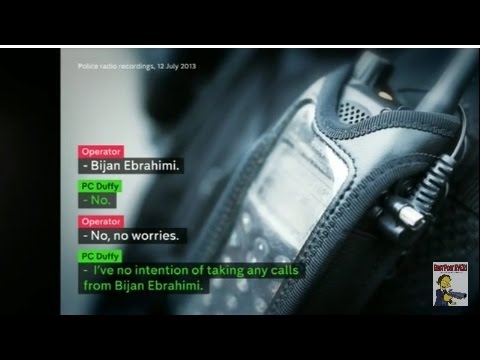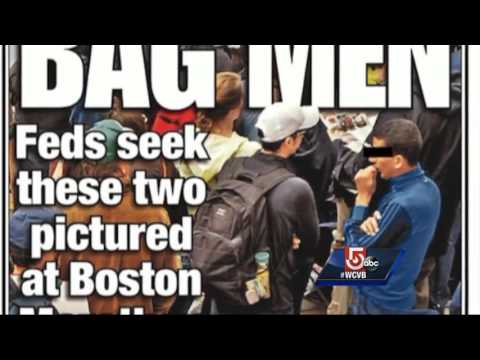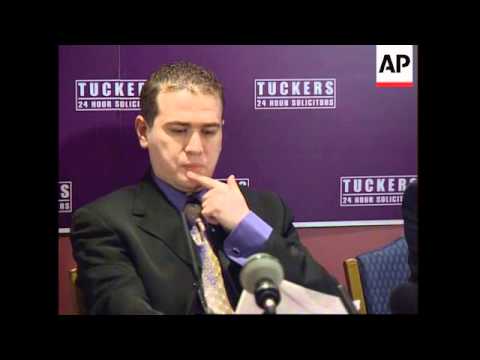The following people come from all walks of life. Some are rich, some are poor. Some are white, some are Middle Eastern, East Asian, or Hispanic. The one thing they have in common is that circumstances conspired to make them appear guilty of a terrible crime they had nothing to do with. Think it couldn’t happen to you? This list suggests we should think again.
10 Richard Jewell
Picture the scene. You’re a security guard assigned to protect spectators at a high-level event. As part of your rounds, you discover a suspicious-looking bag. You immediately clear the area of people. When the bag explodes only minutes later—killing one and injuring over 110—your quick thinking has demonstrably saved lives. What do you expect to happen next? If you answered that you’ll be hailed as a hero, bad luck. When this exact scenario happened at the 1996 Atlanta Olympic Games, security guard Richard Jewell wasn’t publicly celebrated. He was implicated by the FBI in perpetrating an act of domestic terrorism. Although Jewell had demonstrably saved lives, the media was quick to paint him as a monster. The Atlanta Journal identified him as the focus of police attention, leading to a media feeding frenzy. Reporters descended on the heavyset security guard “like piranha on a bleeding cow.” They followed him to and from his home, spending all night outside his windows and yelling questions designed to provoke him. The FBI raided his apartment multiple times. On the basis of the media coverage, two bombing victims filed lawsuits against him. He became a national hate figure. And it was all for nothing. Jewell was cleared in late 1996. In 2003, right-wing nutjob Eric Rudolph was arrested for the bombing and three other attacks that had targeted gay bars and abortion clinics.
9 Yoshiyuki Kono
One summer evening in 1994, Japanese doomsday cult Aum Shinrikyo quietly released a cloud of sarin nerve gas over a leafy suburb of Matsumoto. The attack was a test run for their infamous 1995 gassing of the Tokyo subway. It certainly worked. As the area’s residents slept, the gas killed eight people and seriously injured 200. One of those affected was Yoshiyuki Kono. A machinery salesman, Kono was forced to watch as his wife succumbed to convulsions brought on by the sarin, blood foaming from her mouth. He made the first call to authorities, who promptly decided that he had to be the man behind the attack. Despite having no experience in making sarin (a relatively difficult weapon to make), Kono was publicly identified as the killer. Police had found photograph-processing chemicals on his property and concluded that he’d accidentally released the sarin. Even as Kono lay in the hospital, not far from his wife who was dying of sarin poisoning, they briefed the media against him. Papers wrote up false quotes attributed to Kono that took responsibility for the attack. By the time Kono was released from the hospital, everyone in Japan was against him. Shockingly, he remained a suspect even after Aum gassed the Tokyo subway nine months later. It wasn’t until 2003 that he received an official apology, long after Aum had taken responsibility for the Matsumoto incident.
8 Bijan Ebrahimi
Sometimes, a crime doesn’t even have to have been committed for someone to suffer the consequences. In 2013, neighbors of Bijan Ebrahimi—a disabled Iranian refugee living in Bristol, UK—decided, based on absolutely no evidence, that he was a pedophile. Ebrahimi had been filming local scumbag Lee James as James got drunk in the street, hoping to use the footage as evidence that his neighborhood was plagued with antisocial behavior. James allegedly thought that Ebrahimi was filming his two daughters. He kicked his way into Ebrahimi’s flat and threatened to “f—k him up.” You can see footage of the encounter in the video above. Understandably scared, Ebrahimi called the police. The police responded by arresting him. Despite the footage of James threatening the disabled man, local police believed James’s story that Ebrahimi had been filming his kids. Ebrahimi was booked for “breaching the peace.” As he was led away, James yelled to the police that he would “take the law into his own hands.” Others shouted that Ebrahimi was a pedophile. At the station, Ebrahimi begged the police for protection. They refused. The next morning, Ebrahimi was released to a waiting mob. James had been spreading rumors about the refugee, and everyone believed him. Over the next two days, Ebrahimi would make 12 calls to the police. At one point, he said that his life was in danger and begged them to help him. His pleas were ignored. Just past midnight on Sunday, July 14, scumbag Lee James kicked Ebrahimi half to death outside his flat and then murdered him by setting him on fire. Neighbors refused to help. Despite being a wholly innocent man, Ebrahimi lost first his dignity and then his life for a nonexistent crime.
7 Sally Clark
If the tragic story of Bijan Ebrahimi made you angry at the UK’s justice system, wait until you read the tale of Sally Clark. A successful lawyer, she had the misfortune to have two children succumb to cot death—one in 1996 and one in 1998. Police then arrested this grief-stricken mother for murdering her children. At this point, it could still be argued that the police were doing their job. Two cot deaths in a row is fairly unlikely after all. It wasn’t until the case came to trial that things really fell apart. Two “expert” witnesses took the stand and lied to the court to make Clark look like a criminal. The first was Professor Sir Roy Meadow. A pediatrician, he claimed that the chances of a family suffering two cot deaths in a row were “1 in 73 million.” In reality, experts believe that it could be anywhere between 1 in 100 and 1 in 8,500. The Royal Statistical Society said that Meadow had no basis for his statement. Even worse was Dr. Alan Williams. A pathologist, he deliberately withheld evidence of bacteria in one of the dead children’s bloodstreams that could have led to the baby’s death. Doubly misled, the jury convicted Clark. She was jailed in 1999. It wasn’t until 2003 that the failings of the “expert” witnesses came to light. Clark was released and pardoned. Sadly, the story doesn’t end there. Clark was so messed up by her ordeal that she became an alcoholic. She died in 2007 of alcohol poisoning. Meanwhile, Meadow and Williams are now once again working in medicine.
6 Salaheddin Barhoum
The explosion of two pressure-cooker bombs at the Boston Marathon in 2013 sparked one of the largest manhunts in recent US history. The city ground to a halt for days. Online, millions of people turned into armchair detectives, pouring over photos of the marathon. Desperate for a scoop, the media joined the fray. Enter Salaheddin Barhoum. Watch this video on YouTube Sixteen-year-old Barhoum had the misfortune to be photographed attending the marathon while carrying a bag. He also had the misfortune to look distinctly foreign. (Barhoum was an American citizen). That was enough for the New York Post. At a time when authorities were releasing statements saying that the bombers had been carrying bags, the paper printed a large picture of Barhoum and 24-year-old Yassine Zaimi on their cover under the headline “Bag Men.” It was as close as they could get to just printing the headline “these innocent people are the terrorists who killed your countrymen.” Neither Barhoum nor Zaimi were wanted by authorities, who were already zeroing in on the Tsarnaev brothers. Yet the New York Post’s cover not only defamed them and caused them misery, it put them at a very real risk of being assaulted by people who saw the cover. Luckily, that didn’t happen. After a nerve-shredding couple of days as hate figures, Barhoum and Zaimi were cleared when the Tsarnaev brothers’ images were released. The New York Post tried to weasel out of paying them a penny in compensation. It didn’t work.
5 Lotfi Raissi
In the aftermath of 9/11, the world went into overdrive trying to find anyone connected with the terrorist scumbags who’d just murdered 3,000 people. One of the key suspects they were trying to find was whoever trained the killers to fly. Not unreasonably, the feds assumed that this person would be a Muslim airline pilot. Unreasonably, they then decided this pilot was Lotfi Raissi. An Algerian airline pilot living in London, Raissi was arrested only 10 days after the attacks. UK authorities dragged him off to Belmarsh high-security prison and kept him there without trial for 4.5 months. He was told that he would be extradited to the US and that he’d probably be executed. During his stay in Belmarsh, he was kept in solitary confinement for 23 hours a day, something which took a great toll on his mental health. At this point, we should probably point out that the FBI had concluded that he was innocent two whole months before anyone bothered to release him. It gets worse. After Raissi was released due to lack of evidence, it came to light that the 9/11 investigators never thought he should have been arrested in the first place. Nonetheless, Raissi was blacklisted and put on a no-fly list—a pretty damaging move since his job was, y’know, airline pilot. In one fell swoop, this innocent man lost his career, his reputation, and, briefly, his liberty. Thankfully, the UK government later ruled that he was eligible for £2 million in compensation after he was exonerated entirely.
4 Christopher Jefferies
Even more than Richard Jewell, Christopher Jefferies suffered a trial by media. In 2010, student Joanna Yeates was found murdered. At the time, Jefferies was her landlord. Police called him in for questioning—at which point things went crazy. Jefferies looked like a total weirdo. A retired English teacher with a shock of scruffy white hair and an unkempt manner of dress, he was a cruel caricature of a serial killer. The media took one look at this lonely oddball and decided he had to be guilty. The press onslaught that followed was horrendous. Multiple papers ran quotes from people who barely knew him, describing him as a loser with “an obsession with death.” Things got so bad that the books Jefferies taught in his English class were pointed to as evidence of his sick, deranged mind . . . despite being widely read classics of literature written by people like Oscar Wilde. At their worst, the smears entered a surreal, nightmare territory. Disgusting UK tabloid The Sun implied that he was gay and wrote an entire article about how he didn’t like sports—implying that this made him a deviant. The Daily Mirror called him a “Peeping Tom” on its front page and devoted an article to how he liked to wear a “cheesy” scarf. Had Jefferies gone to trial, the media would have already prejudiced any possible jury against him. Luckily, the case never got to trial. Yeates’s neighbor Vincent Tabak confessed to the murder. Evidence proved he was guilty. Two years later, Jefferies was still waiting for a letter of apology from the eight papers that had defamed him.
3 Jean Charles de Menezes
If you were to calculate all the mistakes that led to Jean Charles de Menezes lying dead on a London Tube platform, you’d come to the conclusion that the odds were astronomical. In the aftermath of the 7/7 London bombings that killed 52 people and left hundreds disabled, the Brazilian just happened to be living in the same building as wanted suspect Hussain Osman. De Menezes also just happened to leave for work at a time when the undercover officer charged with filming everyone who came and went was taking a leak. This unlikely set of circumstances would quickly prove fatal. With no video footage, police couldn’t match de Menezes’s face to a passport photo of Osman. Worried that the Brazilian was their fugitive, they tailed him. When de Menezes tried to get off his bus at Brixton, he saw the Tube station was closed. He got back on the same bus. Officers decided that this was a “typical anti-surveillance technique.” They were now convinced that de Menezes was the wanted bomber. The poor man’s luck went from bad to worse. When he got into the station at Stockwell, there was no way he could have known he was being followed by armed police, who were convinced he was about to attack the Tube. When he realized he was about to miss his train, de Menezes started to run. Thinking he was running away from them to detonate a suicide bomb, the officers opened fire. Despite what was later claimed, no witnesses heard the police yell out a warning. Commuters first realized what was going on when de Menezes’s blood splattered onto their clothes. The saddest part? De Menezes didn’t look remotely like Osman, who wasn’t even in the country. The actual bomber was later arrested in Rome. By then, it was too late. De Menezes was dead—killed for a crime to which he had no connection except via bad luck.
2 Oklahoma City’s Muslims
On April 19, 1995, right-wing terrorist Timothy McVeigh exploded a gigantic truck bomb under the Alfred P. Murrah Federal Building in Oklahoma City. The explosion killed 168, including 19 children and three pregnant women. Prior to 9/11, it was the deadliest terror attack to take place on American soil. The bombing, with its ties to Waco and Ruby Ridge, is now inseparable from McVeigh and the militia movement. At the time, though, things weren’t clear-cut. In the immediate aftermath of the blast, suspicion fell squarely on one group: Oklahoma City’s Muslim community. Only two years before, a bomb at the World Trade Center had killed six and injured over 1,000. The conspirators were Islamic fundamentalists. When the Alfred P. Murrah Federal Building collapsed, the media immediately linked the two attacks. The Oklahoma City bomb was described on news shows as probably being the work of Muslims. For those Muslims living in the region, that meant becoming hate figures. A mosque in Indianapolis was shot at. Muslims in the streets were taunted with cries of “baby killer.” Several anonymous callers threatened to bomb Islamic centers in retribution or murder Muslim children. For three whole days, the community lived in a state of sheer terror. Yet all this hatred was for nothing. Unlike 9/11, the bombing was carried out by a white Christian. Thankfully, McVeigh was quickly caught. The region’s Muslims breathed a sigh of relief.
1 Timothy Evans
The case of Timothy Evans makes for extremely uncomfortable reading. A Welshman living in London, he was hanged in 1950 for the murder of his wife, Beryl, and baby, Geraldine. Throughout his trial, Evans had claimed that his downstairs neighbor, John Christie, was the killer. He called him a murderer. Yet circumstances seemed against him. Beryl had been pregnant, and Evans knew he couldn’t afford to care for another baby. To make matters worse, neighbors had sometimes heard him screaming at his wife in what seemed like violent altercations. Police surmised that Evans had attempted to force an abortion on Beryl, only for it go wrong. When they searched Evans’s home at 10 Rillington Place, they found the bodies of Beryl and Geraldine wrapped up in a cloth. The case seemed open-and-shut, and Evans was executed. Fast forward three years, and something unexpected happened. Police raided 10 Rillington Place again and found six female bodies hidden there. The women had been murdered by John Christie, who had used their corpses for sexual pleasure. He’d even chopped one woman up and turned her body parts into furniture. Christie was a serial killer. Evans had been right about him. The resulting scandal helped bring about the abolishment of the death penalty in Britain (albeit only after Christie had been hanged). Evans was posthumously issued a royal pardon. It emerged that police had forced him into signing a false confession, which created a national scandal. Yet, for all that, it didn’t change one simple fact: Timothy Evans had lost his life for a crime that he didn’t commit. In a way, he was John Christie’s final victim.
























